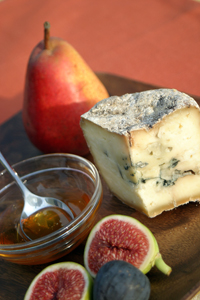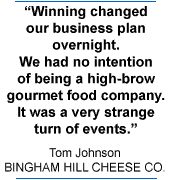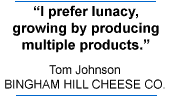 |
|||


|
 |


|
|

September 2, 2005 |
||
| Rustic Blue won Bingham Hill its fame; now company delves into new cheeses Even the company’s first cheese has been updated |
||
By Kate Sander FORT COLLINS, Colo. — Like all good entrepreneurs, Tom and Kristi Johnson entered the cheesemaking business armed with knowledge, training and what they thought was a sound business plan. Self-proclaimed “foodies” who enjoyed good food but who also were pursuing careers outside the cheese industry, the couple decided to change jobs in 1999, modeling their new, tiny Colorado cheesemaking operation after popular microbreweries in the area. They would have their own “microcheesery,” making cheese for local farmers’ markets and Colorado restaurants and retailers. But what is it they say about the best laid plans? The Johnsons’ new business, Bingham Hill Cheese Co., started out well enough. The couple started making Rustic Blue in the fall of 1999, and had initial success in the local area where, as they expected, people were interested in supporting local food products. Then the Johnsons entered their Blue in the American Cheese Society’s annual competition in the summer of 2000. And there the world began to change. The inexperienced cheesemakers’ cheese won the prestigious first place in the Blue cheese class … and the orders started rolling in. And once they started rolling in, they didn’t stop.
“Winning changed our business plan overnight,” Tom Johnson says. “We had no intention of being a high-brow gourmet food company. It was a very strange turn of events.” The company hadn’t been in business long when specialty foods retailer Dean & DeLuca began including Rustic Blue in their catalog. “Supplying cheese to their catalog gave us credibility that would have been difficult to get otherwise and cemented our position in the business,” Johnson says. Five years have now passed since that first fateful contest, and the cheese continues to bring home awards — the most recent of which was a gold medal in the 2005 World Cheese Awards in London. Judges and consumers have described the cheese in many ways, saying it has nutty and chocolate notes and describing its aroma as musty, Cheddary and fruity. Mostly, there’s general consensus that the cheese is drier than most other Blues and has a flavor profile all its own. Over time, the cheese has changed a bit; once made with 100 percent cow’s milk, Johnson now makes Rustic Blue with an 80/20 blend of cow’s milk and sheep’s milk, which he says gives the cheese a little more moisture and character. Despite the cheese’s success, though, the Johnsons haven’t necessarily found the cheese business easy. Getting the business off the ground has had its rough spots, and even experiencing 100 percent growth annually — while seemingly an enviable problem — has it challenges. On top of that, when the Johnsons started out there was nary an artisan Blue cheese in sight. However, the Johnsons weren’t the only ones to notice that trend, and in the past several years Johnson says 20-25 specialty Blues have entered the marketplace. “It’s become extremely competitive,” he says. Rustic Blue has been able to hold its own market share, thanks in large part to the early success it enjoyed. Yet Johnson says it often surprises him what a small part of the business Rustic Blue is compared to the reputation it enjoys; the company makes about 50,000 pounds of Rustic Blue annually, about a sixth of its present annual production of 300,000 pounds. As Bingham Hill has faced increased interest and demand for its cheeses, it has expanded and now produces 14 different types of cheese. From here on out, Johnson says he expects the company to continue growing but not necessarily increasing its volume by that much for the time being. “I prefer lunacy,” he says, laughing, “growing by producing multiple products.” At least once a month, Johnson says he finds himself interrupting the usual work flow for his employees to have them try a new cheese. “Once in a while they stick,” he says. The Johnsons’ children, Nathan, 11, and Sarah, 9, are the ultimate taste testers. The two have helped out at the cheese plant with cleaning and packaging, and their dad says they have discerning taste buds. “If it doesn’t pass their palate, we won’t sell it,” he says. One of the company’s most successful products has been its soft spreadable cheeses introduced in 2002. The advantage of these cheeses is that they don’t require the time, space and capital investment to age them, he says. The cheese has proven to be a solid income maker for Bingham Hill, smoothing out the company’s cash flow. Kroger recently began carrying the cheese and Super Targets soon will as well. Other specialty cheeses the company has introduced over the past few years include its Poudre Puffs and Tumbleweeds, small hand-formed balls that have a mild taste of fresh cream and mushrooms (Tumbleweeds are Poudre Puffs dusted with sage, rosemary, and red chile flakes). Others include Harvest Moon, a washed-rind cheese, and Sheepish Blue, a Blue cheese made entirely with sheep’s milk. There also is Angel Feat, a sheep’s milk washed-rind small disk.
Johnson says sheep’s milk cheese has become another somewhat unexpected success for Bingham Hill. A local rancher had asked the Johnsons if they wanted to try sheep’s milk, and now, Johnson says, the company spends almost as much money on the considerably more expensive sheep’s milk as it does on cow’s milk. Earlier this year, Bingham Hill introduced Grand Mesa, a pressed, washed-rind sheep’s milk cheese available in 8-pound wheels. The cheese took second place in its class at this year’s American Cheese Society Competition. A new washed-rind cow’s milk cheese entered the company’s lineup this past year as well. In addition, Bingham Hill made its first foray into goat’s milk this year with Aspen Log, an 8-inch log made with a blend of cow, goat and sheep’s milk. All of this growth has necessitated some changes. The company now has 14 full-time employees and five part-time employees. A new production room will be finished this fall, and the small 2,000-square-foot building the company started its production in will be torn down. Johnson is looking forward to the company’s future. In some ways, the company is in a difficult stage — it’s not a tiny artisan cheesemaker but neither is it a large one. He anticipates sustained, reasonable growth, noting that he has several ideas for possible cheeses still on the back burner. “You have to keep growing to keep vital,” he says. CMN
|
||
| CMN article search |
|
|
© 2025 Cheese Market News • Quarne Publishing, LLC • Legal Information • Online Privacy Policy • Terms and Conditions
Cheese Market News • Business/Advertising Office: P.O. Box 628254 • Middleton, WI 53562 • 608/831-6002
Cheese Market News • Editorial Office: 5315 Wall Street, Suite 100 • Madison, WI 53718 • 608/288-9090

 Quickly, Bingham Hill and its Rustic Blue were well-known in high-end restaurants from New York to San Francisco, and the cheese was finding a place on the shelves of specialty foods stores. While it is available locally, the majority of the cheese’s sales are outside the area.
Quickly, Bingham Hill and its Rustic Blue were well-known in high-end restaurants from New York to San Francisco, and the cheese was finding a place on the shelves of specialty foods stores. While it is available locally, the majority of the cheese’s sales are outside the area.
 Bingham Hill arranges with cooperative Dairy Farmers of America to buy the cow’s milk of one dairy so the quality of the milk is consistent. The sheep’s milk comes from one operation as well.
Bingham Hill arranges with cooperative Dairy Farmers of America to buy the cow’s milk of one dairy so the quality of the milk is consistent. The sheep’s milk comes from one operation as well.